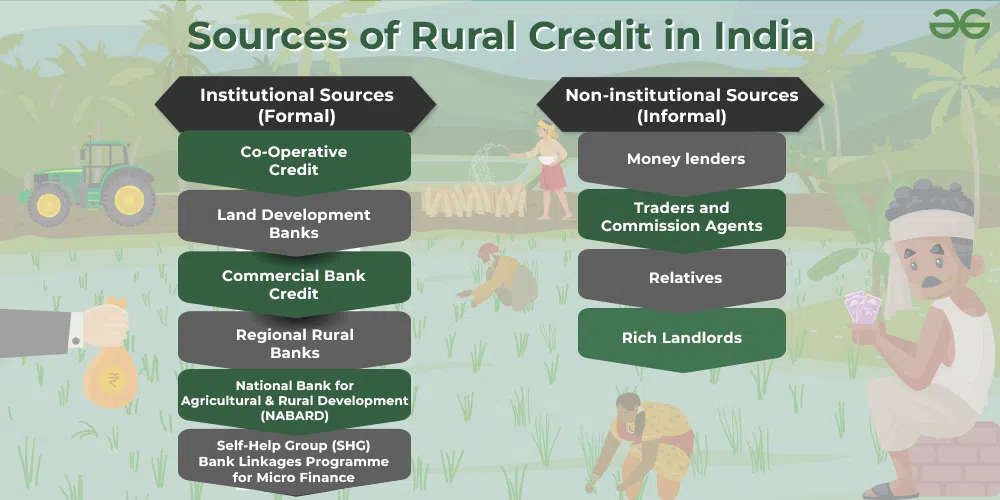Rural India on the Verge of Unlocking Huge Economic Potential: Rural India has long been the backbone of the nation’s economy, contributing significantly to agriculture, trade, and small-scale enterprises. Millions of farmers, traders, and self-employed individuals rely on credit to meet seasonal needs, purchase agricultural inputs, or invest in small ventures. For decades, this borrowing was often informal — sourced from friends, family, or moneylenders — with high interest rates and personal obligations.
Over the past few years, the financial landscape has transformed. Banks, NBFCs, microfinance institutions (MFIs), and cooperatives now provide formal loans with competitive interest rates, transparent repayment terms, and professional management. However, despite increased access to credit, a significant challenge persists: credit monitoring. Rural borrowers often remain unaware of how their borrowing and repayment behavior impacts their financial reputation, eligibility for future loans, and the interest rates they are offered.
The untapped potential in rural financial services is immense. With proper monitoring tools, rural households can make informed borrowing decisions, invest in farm equipment, expand small businesses, and even support education. Yet, without knowledge of their credit scores and reports, many remain invisible to formal lenders, limiting their ability to fully leverage the benefits of the formal financial system.
Understanding Credit Monitoring and Its Importance
What Is Credit Monitoring?
Credit monitoring refers to the process of tracking your credit report and score, which reflect your borrowing and repayment behavior. In India, individual credit scores range from 300 to 900, with higher scores signaling reliability. Small businesses are given a credit rank between 1 and 13, where 1 indicates the least risk. These numbers directly influence loan terms, interest rates, and access to financial products.
For rural borrowers, regular monitoring ensures they are aware of errors, late payments, or other activities that could affect their future borrowing capacity. Awareness of their credit status empowers them to make timely decisions and move towards affordable formal lending.
The Awareness Gap in Rural India
The issue is not financial indiscipline. Many rural borrowers repay loans on time, save consistently, and avoid over-leveraging. The problem lies in lack of awareness. Most rural borrowers do not realize that every missed payment or delayed installment leaves a digital footprint. Over time, this history determines whether they qualify for future loans and at what interest rate.
In contrast, urban borrowers increasingly track their credit behavior, correct errors, and proactively manage their scores. This disparity in awareness contributes to the broader urban-rural financial inclusion gap.
Overcoming Infrastructure and Accessibility Challenges
Most credit monitoring tools assume reliable internet access, digital literacy, and comfort with English-language apps, which are not always present in rural areas. For monitoring to be effective, tools must be:
- Mobile-first and data-light, running on basic smartphones.
- Available in vernacular languages to ensure understanding.
- Integrated with familiar platforms, such as UPI apps, government subsidy portals, or cooperative society systems.
By addressing these infrastructure and accessibility challenges, rural borrowers can use credit monitoring effectively to enhance their financial management.
Read about: KHPT Recruitment 2025 – 08 State Program Officer पदों के लिए आवेदन करें
Credit Monitoring for Rural Borrowers
Regularly tracking credit reports and scores offers several advantages:
- Error Detection: Borrowers can spot inaccuracies in their credit history and request corrections.
- Timely Repayment Awareness: Understanding how on-time payments improve scores helps maintain a healthy credit profile.
- Business vs. Personal Credit Management: Borrowers can separate household loans from business loans, strengthening their business creditworthiness.
- Transition to Formal Credit: Monitoring enables movement away from high-cost informal lending towards affordable bank or NBFC loans.
- Empowerment: Credit monitoring transforms rural borrowers from passive recipients to active managers of their financial destiny.

Policy and Ecosystem Imperatives
For credit monitoring to achieve its potential impact, stakeholders must collaborate:
- Policy Integration: Credit monitoring should be incorporated into government-led financial literacy campaigns.
- Fintech Solutions: Lightweight apps in regional languages can simplify the monitoring process.
- Public Digital Infrastructure: Existing government portals delivering subsidies or benefits can integrate credit report access to expand reach.
By creating an ecosystem that prioritizes awareness and accessibility, stakeholders can enable rural borrowers to fully leverage formal financial systems.
Conclusion
Rural India is no longer isolated from formal credit systems. Digital banking, UPI, and competitive lending products have opened doors for millions of rural borrowers. Yet, without awareness and monitoring, much of this potential remains untapped.
Credit scores and reports are more than numbers — they are tools for empowerment. Regular monitoring allows borrowers to improve financial discipline, access better loan terms, and make strategic decisions for household and business growth.
Bridging the awareness and accessibility gap will unlock the vast potential of rural India’s financial ecosystem. With informed credit management, rural borrowers can transform borrowing from a necessity into a catalyst for prosperity, driving inclusive growth for the entire nation.
Also read: KHPT Recruitment 2025 – 08 State Program Officer पदों के लिए आवेदन करें
FAQs
1. Why is credit monitoring important for rural borrowers?
Credit monitoring helps borrowers track repayment behavior, spot errors in their reports, and improve their scores. This ensures better access to affordable loans, reduces dependence on informal lenders, and empowers borrowers to manage their financial future proactively.
2. How are credit scores calculated in India?
Individual credit scores in India range from 300 to 900. Factors include repayment history, loan utilization, outstanding debt, and length of credit history. Higher scores indicate reliability, while lower scores suggest higher risk to lenders.
3. Why do rural borrowers have less awareness about credit monitoring?
Limited internet access, low digital literacy, and language barriers make it difficult for many rural borrowers to check their credit reports. Additionally, many are unaware of the importance of maintaining a digital credit footprint.
4. How can fintech solutions improve rural credit monitoring?
Lightweight mobile apps in regional languages, integrated with familiar platforms like UPI, can make credit monitoring accessible. Such solutions allow borrowers to track their financial behavior, check scores, and receive guidance in real-time.
5. What role can policy makers play in enhancing credit monitoring?
Governments can integrate credit monitoring into financial literacy campaigns, provide public access through existing subsidy portals, and encourage collaboration between banks, NBFCs, and fintech firms to ensure rural borrowers are informed and empowered.

1 thought on “With Credit Monitoring, Rural India on the Verge of Unlocking Huge Economic Potential”